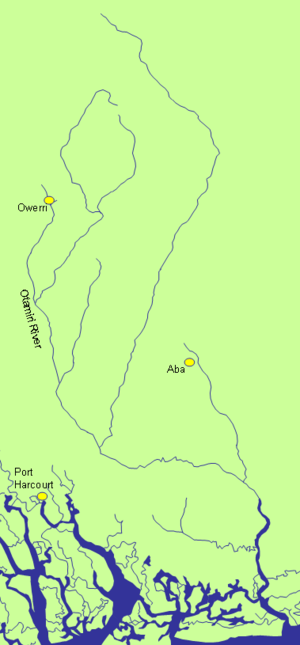Otamiri River

The Otamiri River is one of the main rivers in Imo State, Nigeria. The river takes its name from Ota Miri, a deity who owns all the waters that are called by his name, and who is often the dominating god of Mbari houses.[1] The river runs south from Egbu past Owerri and through Nekede, Ihiagwa, Eziobodo, Olokwu Umuisi, Mgbirichi and Umuagwo to Ozuzu in Etche, in the Rivers State, from where it flows to the Atlantic Ocean.[2] The length of the river from its source to its confluence at Emeabiam with the Uramiriukwa River is 30 kilometres (19 mi).[3]
The Otamiri watershed covers about 10,000 square kilometres (3,900 sq mi) with annual rainfall of 2,250 to 2,500 millimetres (89 to 98 in). The watershed is mostly covered by depleted rain forest vegetation, with mean temperatures of 27 °C (81 °F) throughout the year. Conversion of the tropical rainforest to grassland with slash and burn practices is degrading soil quality.[4]
The Otamiri is joined by the Nworie River at Nekede in Owerri, a river about 9.2 kilometres (5.7 mi) long.[3] The Nworie river is subject to intensive human and industrial activities, and is used as a source of drinking water by the poor when the public water system fails. The Nworie is polluted by organic wastes but in 2008 was not above acceptable levels of chemical pollution.[5] Waste management in Owerri is inefficient and contributes to pollution of the river.[6] Most of the wastes from Owerri are dumped at the Avu landfill in Owerri West on the Port Harcourt highway, which creates a high concentration of phosphate and nitrate in the Otamiri.[7]
South of Owerri the river flows through an alternating sequence of sands, sandstones and clay-shales.[8] Random sand samples from the bank of Otamiri River between Chokocho and Umuanyaga, Etche Local Government Area, Rivers State showed that 86 percent of the sand particles are within the ideal range for glass making.[9]
References
- ↑ George Thomas Basden (1966). Among the Ibos of Nigeria. Routledge. p. 100ff. ISBN 0-7146-1633-8.
- ↑ "THE GREAT OTAMIRI RIVER". Ihiagwa town. Retrieved 2009-10-14.
- ↑ 3.0 3.1 Anyanwu ft C. "A COMPARATIVE EVAWATION OF EARLY RAINS PHYTOPL.ANKTON PRODUCTIVITY OF NWORIE AND OTAMORI RIVERS. OWERRI IMO STATE, NIEROA.". Department of Agricultural Science, A Ivan Ikoku College of Education. Retrieved 2009-10-14.
- ↑ Emmanuel Uzoma Onweremadu. "Soil Mercury Distribution in a Forest-Savanna Mosaic in Relation to Soil Fertility". Research Journal of Environmental Toxicology, 2007, Volume: 1, Issue: 4, Page No.: 158-166. Retrieved 2009-10-14.
- ↑ Alex D.W. Acholonu (2008). "Water quality studies of Nworie River in Owerri, Nigeria". Mississippi Academy of Sciences. Retrieved 2009-10-14.
- ↑ Paul C. NJOKU, Phil M. DELHI. "MUNICIPAL WASTE MANAGEMENT DISPOSAL TECHNOLOGY AT OTAMIRI RIVER OWERRI NIGERIA". Slovenskega Rudarskega Društva Inženirjev in Tehnikov. Retrieved 2009-10-14.
- ↑ K. M. Ibe, J. C. Njoku (August 1999). "MIGRATION OF CONTAMINANTS IN GROUNDWATER AT A LANDFILL SITE, NIGERIA". Journal of the International Association for Environmental Hydrology.
- ↑ K. O. UMA* & M. O. KEHINDE. "Quantitative assessment of the groundwater potential of small basins in parts of southeastern Nigeria". liydrological Sciences -Journal- des Sciences ffydrohgiquesf31,4, 8/1992. Retrieved 2009-10-14.
- ↑ USHIE, F.A.; ESU, E.O.; UDOM, G.J. "A Preliminary Evaluation of Otamiri River Sands for the Production of Plain Glass". Journal of Applied Sciences and Environmental Management, Vol. 9, No. 1, 2005, pp. 65-68. ISSN 1119-8362. Retrieved 2009-10-14.